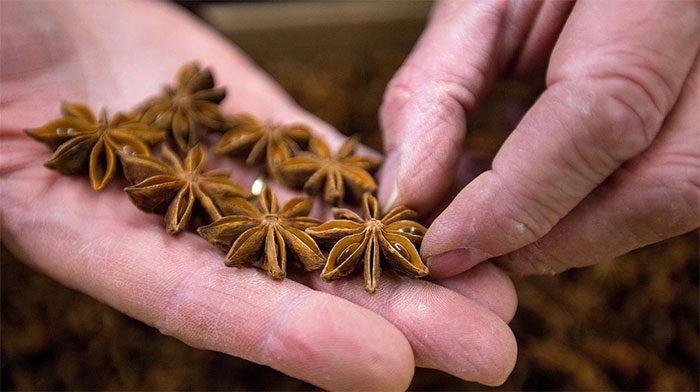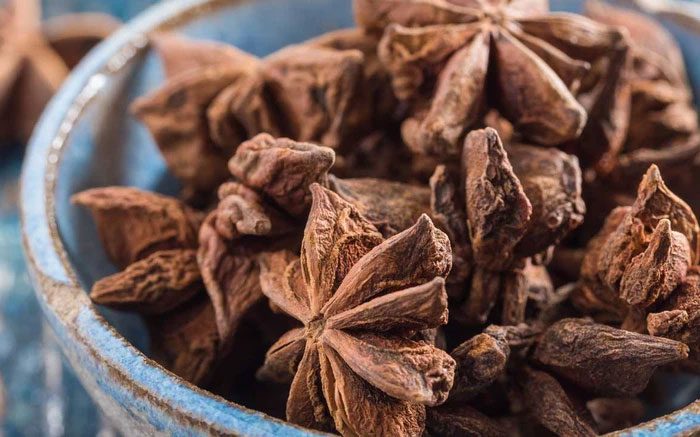Star anise is a unique spice known for its distinct flavor and strong aroma reminiscent of licorice or cinnamon. Moreover, star anise also has health-enhancing properties. Therefore, it has become one of the preferred spices in food preparation.
1. Nutrients Found in Star Anise
Star anise contains various nutrients beneficial for health. Although this spice has negligible amounts of carbohydrates, fats, and calories, it is rich in minerals and potent bioactive compounds. Chemical analyses reveal that star anise contains a significant amount of various micronutrients and macronutrients, including calcium, magnesium, potassium, sodium, copper, iron, and manganese.
Some of the most researched compounds in star anise: Shikimic acid, Anethole, Linalool, Gallic acid, Quercetin, Limonene. These chemicals exhibit antibacterial, antioxidant, and anti-inflammatory properties.
However, the most critical component of star anise is its potent chemicals, which contribute to its numerous health benefits. Studies show that these bioactive compounds belong to various groups of phytochemicals, including flavonoids, polyphenols, terpenes, alkaloids, steroids, and tannins.

Star anise contains a significant amount of micronutrients and macronutrients beneficial for health. (Image: ST).
2. What Are the Benefits of Star Anise?
Star anise is a rich source of phytochemicals, offering numerous positive effects on health. Here are some notable medical benefits of star anise:
2.1. Antiviral Properties
One of the most common pharmacological properties of star anise is its content of shikimic acid. Shikimic acid is a compound with strong antiviral capabilities. In fact, it is one of the main active ingredients in Tamiflu, a popular medication for treating influenza.
Several in vitro studies have also indicated that star anise essential oil may treat various viral infections.
2.2. Antifungal Effects
Star anise exhibits antifungal properties due to its content of the flavonoid anethole. This compound not only imparts a unique flavor to the spice but also possesses strong antifungal benefits.
Specifically, some studies suggest that other bioactive compounds found in star anise essential oil, such as terpene linalool, can inhibit the formation of biofilms and cell walls of infectious fungi in humans.
2.3. Antibacterial Properties
Research indicates that the bioactive compounds in star anise can help combat various bacteria. Among them, shikimic acid, linalool, and anethole exhibit the highest antibacterial properties.
Furthermore, star anise is believed to prevent the growth of E. coli bacteria and protect against conditions such as pneumonia and diarrhea.
Notably, some studies have revealed that extracts from star anise are as effective as antibiotics against many antibiotic-resistant pathogenic bacteria. This could be particularly useful for developing new antibiotic drugs in the future.
2.4. Blood Sugar Regulation
The anethole compound in star anise also helps regulate blood sugar levels by playing a crucial role in carbohydrate metabolism, thereby adjusting blood glucose concentrations.
2.5. Cardiovascular Health
Some studies suggest that star anise can regulate blood pressure, control lipid levels in the blood, and reduce the accumulation of plaque in the hearts of mice. The rich antioxidant content of this spice may support cardiovascular health by protecting heart cells from oxidative stress and free radical damage.
2.6. Cancer Cell Resistance
Star anise has a high antioxidant content, which can protect cells from damage caused by free radicals and oxidation—factors that contribute to various diseases, including cancer.
Additionally, some studies indicate that star anise has the ability to reduce oxidative stress and the risk of tumors in animals. This spice has also been shown to enhance the levels of certain enzymes known for their cancer-preventive roles.
However, since most of these studies have been conducted on animals, further research on humans is needed.

Star anise may also cause some side effects.
3. Precautions When Using Star Anise
Star anise is considered safe for most people, but it can also cause some side effects. Some individuals may experience mild itching or rashes, while others may suffer from mild to severe gastrointestinal pain and inflammation when using star anise.
It is important to note that excessive use of star anise may also lead to interactions with medications used for cancer treatment or hormone regulation.
Additionally, star anise contains compounds that affect hormones, particularly estrogen levels. Therefore, it is best to avoid or limit this spice if you are experiencing hormonal disorders.
If you are taking any prescribed medications or are uncertain about your allergy status, it is advisable to consult a doctor before adding star anise to your diet.
However, star anise is generally used as a spice originating from China or Vietnam. There is a type of anise called Japanese star anise (Illicium anisatum), which is highly toxic and considered safe only for decorative purposes.
Researchers have found potent neurotoxins in Japanese star anise that can cause serious medical issues such as nausea, hallucinations, and seizures. Such side effects are most commonly seen in infants given Japanese star anise tea.
|
Comparison of Vietnamese and Chinese Star Anise with Japanese Star Anise
|
Overall, it can be said that star anise has numerous health benefits. You can use this spice to cook many different dishes such as curries, soups, and broths, or add it to desserts, sweets, and baked goods to enhance health, especially during flu season.


















































